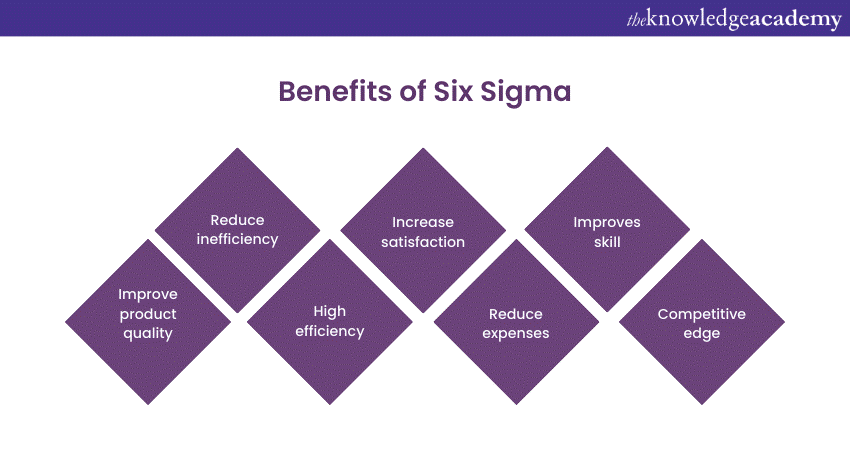We may not have the course you’re looking for. If you enquire or give us a call on 01344203999 and speak to our training experts, we may still be able to help with your training requirements.
Training Outcomes Within Your Budget!
We ensure quality, budget-alignment, and timely delivery by our expert instructors.

Six Sigma has revolutionised the way organisations approach quality improvement and process optimisation. Learning about Six Sigma Advantages and Disadvantages can give you insight into whether to implement it.
Understanding the advantages and disadvantages of Six Sigma is essential to use it effectively. By implementing it, organisations can experience improved quality, reduced defects, and enhanced customer satisfaction. In this blog, you will learn about the Six Sigma Advantages and Disadvantages and how it can impact your organisation.
Table of Contents
1) Advantages of Six Sigma
a) Enhanced quality
b) Process optimisation
c) Data-driven decision making
2) Disadvantages of Six Sigma
a) Time-intensive
b) Complex methodology
3) Conclusion
Advantages of Six Sigma

Implementing Six Sigma offers a wide range of advantages from enhanced quality to continuous improvement. Here are the key benefits organisations can experience by adopting Six Sigma principles and methodologies:
Enhanced quality
Implementing Six Sigma leads to a significant improvement in the quality of products and services. Organisations can consistently meet or exceed customer expectations by identifying and eliminating defects. This focus on quality enhances customer satisfaction and helps build a strong reputation for the organisation.

Process optimisation
Six Sigma emphasises process optimisation by identifying and eliminating waste and inefficiencies. By streamlining processes and reducing variation, organisations can achieve higher levels of productivity and efficiency. This, in turn, leads to cost savings and improved overall performance.
Data-driven decision making
Six Sigma relies heavily on data analysis to drive decision-making. This approach ensures that decisions are based on proper facts and data rather than opinions or gut feelings. Organisations can minimise the risk of making incorrect or biased judgments by making data-driven decisions.
Increased customer satisfaction
Six Sigma plays a crucial role in enhancing customer satisfaction. Moreover, satisfied customers are more likely to become repeat customers and recommend the organisation to others, contributing to long-term success. It does this by:
a) Improving quality: Six Sigma focuses on quality improvement by systematically identifying and addressing defects, errors, and process variations.
b) Reducing defects: Implementing Six Sigma leads to fewer errors, rework, and customer complaints, ultimately improving the overall quality of products and services.
c) Fulfilling customer needs: It improves customer satisfaction by delivering services and products that align with customer needs and expectations.
Cost reduction
By eliminating defects, reducing waste, and optimising processes, Six Sigma helps organisations achieve cost savings. It streamlines operations and makes them more efficient, thereby reducing unnecessary expenses:
a) Rework: Six Sigma focuses on identifying and addressing the root causes of defects, aiming to eliminate the need for rework.
b) Scrap: Six Sigma emphasises waste reduction, including minimising scrap materials and thereby minimising expenses related to that.
c) Customer complaints: Six Sigma aims to enhance client satisfaction by delivering high-quality products and services.
Employee engagement and skill development
Implementing Six Sigma involves training employees in problem-solving methodologies and statistical analysis. This investment in employee development leads to increased engagement and empowerment. Employees become more involved in process improvement initiatives, contributing their knowledge and skills to drive positive organisational change.
Competitive advantage
Six Sigma provides organisations with a competitive edge in the market. Organisations can differentiate themselves from competitors by consistently delivering high-quality products and services. This competitive advantage can attract new customers, retain existing ones, and open up opportunities for business growth.
Sustainable improvement
Six Sigma is not a one-time fix but a continuous improvement process. It establishes a culture of ongoing organisational improvement, where processes are regularly reviewed, analysed, and optimised. This commitment to continuous improvement leads to sustainable long-term results and ensures that the organisation stays ahead of its competitors.
Continuous improvement culture
Six Sigma fosters a culture of continuous improvement within the organisation. It encourages employees to seek opportunities for improvement consistently and empowers them to make data-driven decisions. This culture of continuous improvement becomes ingrained in the organisation's DNA, leading to a mindset where everyone is focused on driving positive change.
Application in various industries
Six Sigma has proven effective in many industries, including manufacturing, healthcare, finance, telecommunications, and more. Its principles and methodologies can be adapted to suit the specific requirements of each industry. This versatility makes it a valuable tool for organisations across different sectors.
Elevate your professional profile with a globally recognised Six Sigma qualification and unlock endless opportunities for career advancement with our Six Sigma Yellow Belt Training.
Disadvantages of Six Sigma
While Six Sigma brings numerous advantages, it's essential also to consider the potential disadvantages. Understanding these challenges can help organisations make informed decisions and address potential limitations effectively. Explore the following drawbacks associated with its implementation.
Time-intensive
Implementing Six Sigma requires a significant investment of time and resources. It can be lengthy, and organisations must allocate adequate time and resources to ensure successful implementation. It involves the following tasks:
1) Training employees
2) Conducting data analysis
3) Implementing improvement projects
Complex methodology
Six Sigma is a rigorous and complex methodology that requires a deep understanding of statistical analysis and problem-solving techniques. This complexity can make adopting and implementing it is challenging for organisations without proper training and support.
Resistance to change
Introducing Six Sigma may face resistance from employees who are accustomed to existing processes and methodologies. Change management becomes crucial to overcome resistance and ensure the smooth adoption of Six Sigma throughout the organisation.
Overemphasis on metrics
While metrics are an essential component of Six Sigma, there is a risk of overemphasising metrics and becoming solely focused on meeting numerical targets. This can lead to a neglect of other important aspects like:
a) Customer Satisfaction
b) Employee engagement
c) Innovation
Overreliance on experts
Six Sigma often relies on the expertise of trained professionals known as Black Belts and Green Belts. While their knowledge and skills are valuable, an overreliance on these experts can create a dependency and hinder the organisation's ability to sustain improvement efforts in the long run.
Embark on a transformative journey of process excellence and empower yourself with our Six Sigma Black Belt Training – Signup now!
Lack of flexibility
The structured nature of Six Sigma can sometimes limit flexibility in responding to rapidly changing business environments. Organisations need to strike a balance between standardisation and the ability to adapt to evolving market conditions.
Implementation challenges
Implementing Six Sigma across an entire organisation can be a complex task. It requires strong leadership, effective communication, and collaboration across different departments and functions. Failure to address these implementation challenges can hinder its successful adoption.
Overemphasis on defect reduction
While defect reduction is a crucial goal of Six Sigma, organisations should not solely focus on eliminating defects at the expense of other important factors such as customer experience, employee satisfaction, and organisational growth.
Conclusion
We hope you read and understood everything about Six Sigma Advantages and Disadvantages from this blog. It offers numerous benefits to organisations, including improved quality and customer satisfaction. While it may have some disadvantages, these can be outweighed by the range of benefits it offers. When implemented effectively, it can drive sustainable improvement and long-term success.
Unleash the power of Six Sigma and take your skills to new heights with our comprehensive Six Sigma Certification Training Courses.
Frequently Asked Questions
Upcoming Business Improvement Resources Batches & Dates
Date
 Lean Six Sigma Green Belt
Lean Six Sigma Green Belt
Mon 13th May 2024
Sat 18th May 2024, Sun 19th May 2024
Mon 20th May 2024
Tue 28th May 2024
Mon 3rd Jun 2024
Mon 10th Jun 2024
Mon 17th Jun 2024
Sat 22nd Jun 2024, Sun 23rd Jun 2024
Mon 24th Jun 2024
Mon 1st Jul 2024
Mon 8th Jul 2024
Mon 15th Jul 2024
Sat 20th Jul 2024, Sun 21st Jul 2024
Mon 22nd Jul 2024
Mon 29th Jul 2024
Mon 5th Aug 2024
Mon 12th Aug 2024
Sat 17th Aug 2024, Sun 18th Aug 2024
Mon 19th Aug 2024
Tue 27th Aug 2024
Mon 2nd Sep 2024
Mon 9th Sep 2024
Sat 14th Sep 2024, Sun 15th Sep 2024
Mon 16th Sep 2024
Mon 23rd Sep 2024
Mon 30th Sep 2024
Mon 7th Oct 2024
Sat 12th Oct 2024, Sun 13th Oct 2024
Mon 14th Oct 2024
Mon 21st Oct 2024
Mon 28th Oct 2024
Mon 4th Nov 2024
Sat 9th Nov 2024, Sun 10th Nov 2024
Mon 11th Nov 2024
Mon 18th Nov 2024
Mon 25th Nov 2024
Mon 2nd Dec 2024
Sat 7th Dec 2024, Sun 8th Dec 2024
Mon 9th Dec 2024
Mon 16th Dec 2024







 Top Rated Course
Top Rated Course


 If you wish to make any changes to your course, please
If you wish to make any changes to your course, please


